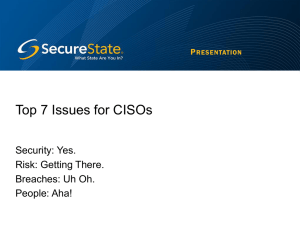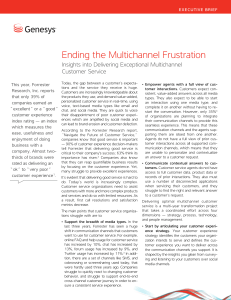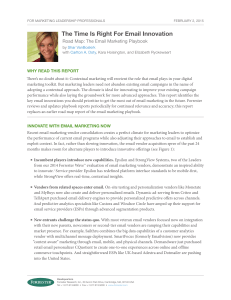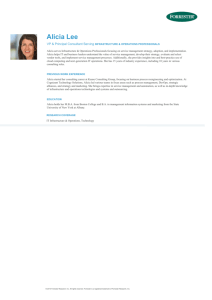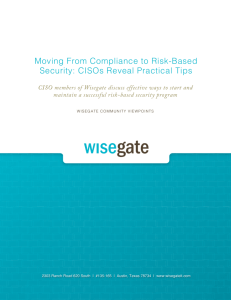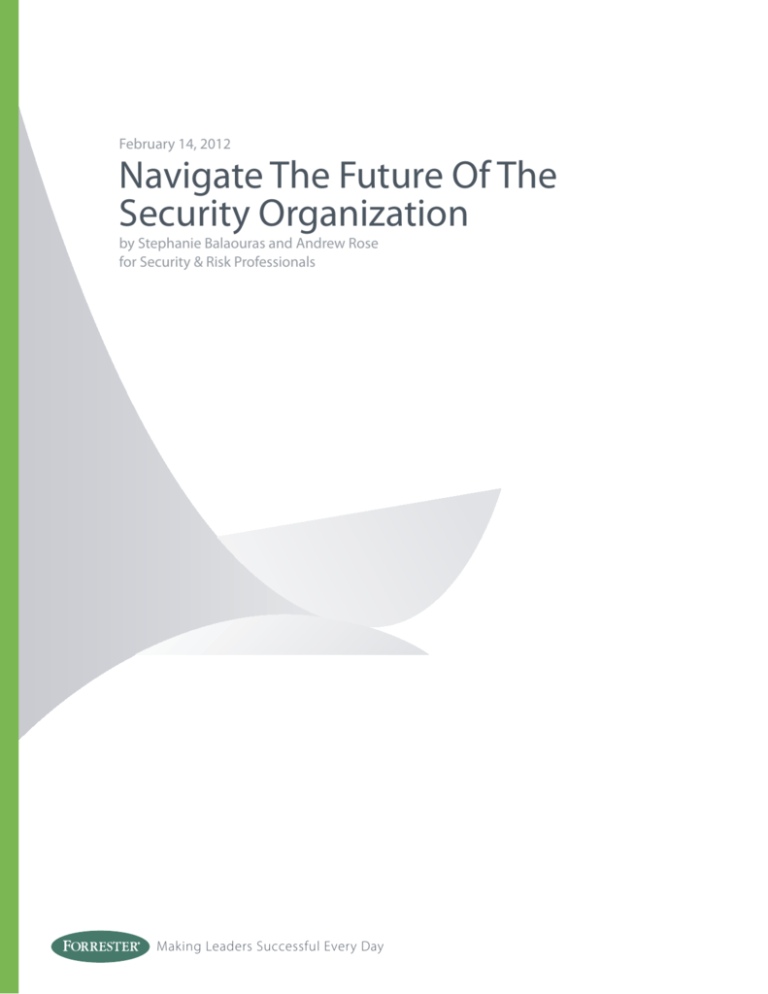
February 14, 2012
Navigate The Future Of The
Security Organization
by Stephanie Balaouras and Andrew Rose
for Security & Risk Professionals
Making Leaders Successful Every Day
For Security & Risk Professionals
February 14, 2012
Navigate The Future Of The Security Organization
by Stephanie Balaouras and Andrew Rose
with Laura Koetzle, Ed Ferrara, Eve Maler, and Nicholas Hayes
Execut i v e S u m mary
This report outlines the future look of Forrester’s solution for security and risk (S&R) executives working
on building a high-performance security program and organization. This report is designed to help you
understand and navigate the major business and IT trends affecting the security organization during the
next five years. Today’s chief information security officers (CISOs) continue to concentrate too much on
tactical activities and day-to-day security operations, unable to escape the reactionary hamster wheel.
Additionally, businesses and other parts of IT routinely circumvent today’s security organization in order
to innovate and avoid hearing the predicted “no” response. So despite all the sensational headlines about
major security breaches, many CISOs find themselves marginalized by their business colleagues. In this
report, Forrester details what CISOs can do to realign with their businesses and transform themselves
into chief business security officers, reasserting their position with management, the board, and the
company as a whole.
tab l e of Contents
2 Despite The Hype, Security Has Declined In
Priority For Business And IT Leaders
CISOs Have Not Focused Enough On Business
Results And Innovation
CISOs Struggle To Create An Appealing Vision
Of The Future
CISOs Are Not Breaking Through The IT Ceiling
5 Turn Yourself Into A Chief Business Security
Officer
Build A Business-Centric Security Program And
Organization
Strengthen Your Position By Expanding The
Scope To Deliver Additional Value
Seek To Embed Security Into Architecture And
Processes Across The Extended Enterprise
WHAT IT MEANS
9 Resist The Urge To Sell Fear, Uncertainty, And
Doubt —Sell Value Instead
10 Supplemental Material
N OT E S & RE S O U R C E S
Forrester interviewed more than 16 vendor
and user companies, including Cisco, CSC, Dell
SecureWorks, Ernst & Young, HP, Juniper, KPMG,
McAfee, Microsoft, Orange Business Services,
RSA Security, SAP, and Verizon.
Related Research Documents
“The Extended Enterprise: A Security Journey”
November 9, 2011
“Don’t Bore Your Executives — Speak To Them In
A Language That They Understand”
July 18, 2011
“Build A Strategic Security Program And
Organization”
May 10, 2010
“Define A Road Map To Accelerate The
Organizational Maturity Of Your Security
Program”
May 7, 2010
© 2012 Forrester Research, Inc. All rights reserved. Forrester, Forrester Wave, RoleView, Technographics, TechRankings, and Total Economic
Impact are trademarks of Forrester Research, Inc. All other trademarks are the property of their respective owners. Reproduction or sharing of this
content in any form without prior written permission is strictly prohibited. To purchase reprints of this document, please email clientsupport@
forrester.com. For additional reproduction and usage information, see Forrester’s Citation Policy located at www.forrester.com. Information is
based on best available resources. Opinions reflect judgment at the time and are subject to change.
2
Navigate The Future Of The Security Organization
For Security & Risk Professionals
despite the hype, SECURITY has declined in priority for business and it leaders
Despite all the sensational headlines about major security breaches, from RSA to Lockheed Martin to
Sony and the continued avalanche of federal, state, and industry-specific regulations, upgrading
security has actually declined as a critical priority from 2008 to 2011 among enterprise IT budget
decision-makers and influencers (see Figure 1).1 It probably seems incomprehensible to most CISOs
that security could decline in importance, especially when the board is dragging them in to present as
many as four times per year. However, between 2008 and today, although the number of security
threats and regulations increased, the grim global economic outlook forced many executives to focus
their attention on IT initiatives that either cut costs (e.g., virtualization, consolidation) or drove growth
and differentiation (e.g., analytics for better decision-making, mobile for employee productivity).
Figure 1 Upgrading Security Has Declined As A Critical Priority
“Which of the following initiatives are likely to be your IT organization’s top
technology priorities over the next 12 months?”
(Respondents selecting “significantly upgrade our security environment” as a critical priority)
2011
(N = 1,531)
2008
(N = 1,823)
16%
20%
Base: Global enterprise IT budget decision-makers at companies with 100 or more employees
Source: Forrsights Budgets And Priorities Tracker Survey, Q2 2011; Enterprise And SMB IT
Budgets And Spending Survey, North America, Europe, And Asia Pacific, Q4 2007
60799
Source: Forrester Research, Inc.
CISOs Have Not Focused Enough On Business Results And Innovation
It’s pathetically clichéd but still true: The business continues to view the security organization as a
policy cop and paranoid custodian that is a barrier to progress and innovation. We spoke to one
expert from a consultancy who routinely hears board members from some of his largest clients
express frustration with the information security (IS) function. He noted, “Many top executives
have had poor relationships with CISOs in the past, and that continues to shape their perceptions
today. They see people in the IS profession as technologists, not equals. The No. 1 complaint from
the board is that they are stuck dealing with very complex and technical people.”
In fact, business leaders at many firms — particularly in the financial services industry — have
become so frustrated with their CISOs that they have created a new, separate position, often called a
“VP of IT risk” or “business information security officer,” specifically to align with the business and
to understand business requirements. This individual then brings these requirements to the CISO,
who is now solely responsible for operational execution. Why is this CISO evisceration happening?
Well, for the past several years, CISOs have not been able to:
February 14, 2012
© 2012, Forrester Research, Inc. Reproduction Prohibited
Navigate The Future Of The Security Organization
For Security & Risk Professionals
·Show how ongoing operational costs and investments support business activities.
Demonstrating return on security investment (ROSI) is a challenge that even top security teams
struggle with. Thus, most CISOs are not even outlining how their day-to-day activities are
adding value to the business or helping protect key corporate assets, such as reputation.
·Manage or keep pace with business demand. Organizations have recognized the importance
of technology and have processes in place to speed its adoption. The business, and in some cases,
other parts of IT, bypass the security organization; they only bring their security colleagues in at
the end of the project and then ask them to “make it secure.”
·Focus on business innovation. Modern business relies on technology. Much of the productivity
enjoyed by business throughout the past decade has been due to extensive automation.2 This rise
in automation introduced new opportunities for data breaches. In 1990, a T1 line providing 1.544
MB per second was very fast. Now connections of 1 to 10 GB per second are routine. Hackers can
compromise a lot of information very quickly. At the same time, business has been very
innovative in the use of technology. Security organizations have not kept pace with these changes.
CISOs Struggle To Create An Appealing Vision Of The Future
The current threat landscape is bleak. Not a week goes by without news of another large enterprise
or government agency leaking data or of hackers compromising valuable intellectual property.3
The CISO finds it almost impossible to create an appealing view of the future. The risks to the
organization develop at breathtaking rates, making it difficult to keep up. In addition, the traditional
controls that form the mainstay of the security function are becoming obsolete. These circumstances
force the CISO to:
·Explain why historical solutions are no longer effective. The rapid development of new threats
means that existing controls have become marginalized and ineffective. In a recent discussion
with a global antivirus vendor, we learned that signature-based antivirus (AV) software accounts
for less than half of malware detection on workstations, yet many organizations rely solely on
AV software. Employees who fall for phishing attacks foil the firewalled perimeters we once
relied on to stop known threats. Executives do not enjoy hearing how this arms race is leaving
them increasingly vulnerable.
·Constantly ask for more money to treat new risks. Addressing these developing threats can
require both significant investment and business disruption — and in the current uncertain
economic climate, anyone approaching the board asking for additional resources is unlikely
to be popular. The board often sees the processes and tools commonly required to protect
information as awkward, uninviting, and prohibitively expensive, because the speed of threat
development quickly undermines point solutions. At the same time, CISOs do not have
the necessary metrics programs in place to measure the effectiveness of their controls and
demonstrate the value of these investments.
© 2012, Forrester Research, Inc. Reproduction Prohibited
February 14, 2012
3
4
Navigate The Future Of The Security Organization
For Security & Risk Professionals
·Regularly act as the bearer of bad news. When incidents occur and the security organization
identifies new risks, the CISO has to deliver those messages. “When the IT security manager
comes to my desk, I can often feel the chill in the air before I realize he is there, undoubtedly to
bring bad news again,” said an IT operations manager at a global law firm. To exacerbate the
problem, most CISOs don’t publicize positive security-and-risk-related developments. Thus,
senior executives end up with an unbalanced, unduly negative view of the CISO and of the
organization’s security posture.
CISOs Are Not Breaking Through The IT Ceiling
For many years, Forrester has talked about the importance of business engagement and the
ultimate ambition of security leadership to break through the IT ceiling, to take a business-focused
position, and to provide advice, guidance, and governance to business executives and initiatives.4
Unfortunately, many CISOs today remain far too technology-focused — they fail to balance the
requirements of stopping information loss and security breaches with other business priorities. This
is because many CISOs:
·Lack experience at the boardroom level. To get the attention of C-level executives and boards,
CISOs must communicate in business terms. However, many CISOs are C-level executives in
title only; a majority still report up through IT, typically to the CIO. Most CISOs don’t have a
strong track record of successfully presenting to C-level executives and the board of directors.
·Cannot command respect and influence across multiple business units. CISOs and other
senior security managers most often rise through the security ranks. Since they have not
worked in other parts of IT or in the business, they haven’t developed the relationship- and
influence-building skills and connections that come with moving around the organization. Their
siloed expertise also makes it difficult to work with other IT departments, such as application
development, enterprise architecture, and sourcing and vendor management. Executives
in those departments feel that CISOs don’t speak their language and don’t understand their
department’s unique pressures and challenges.5
·Need to develop stronger business and financial acumen. For a long time, the ability
to understand deep technical threats was a key part of the CISO skill set. No longer.
Communication, budget management, and business acumen are now more important than
deep technical skills. Successful CISOs balance their business focus with the ability to work well
with and learn from specialist technical staff as necessary.
·Are not able to acquire the talent they need. Many CISOs want to build more business-
focused security organizations, but they find that their staff lacks the necessary skills to interact
with the business. As one expert from a security vendor stated, “Some CISOs will make the
leap, but they’re only as good as their teams.” Another security consultant noted that “the No.
February 14, 2012
© 2012, Forrester Research, Inc. Reproduction Prohibited
Navigate The Future Of The Security Organization
For Security & Risk Professionals
1 thing is the availability of capable people. With our large global clients, their ability to move
and transform quickly is inhibited by the expertise and skills of the team, especially the soft
and personal skills.” Talking in business terms is not limited to the CISO; the entire security
organization must understand the business priorities as well.
turn yourself into a chief business security officer
If CISOs want to remain the most senior security and risk executives at their firms, they will need
to rethink the roles and responsibilities of the security organization, its top priorities and initiatives,
and the services and value it delivers to the business. They must also reexamine the individual skills
that they build within the security organization and embrace a fundamental redesign of security
architecture and processes. In fact, chief information security officers should view themselves as the
chief business security officers (CBSOs) (see Figure 2).
Figure 2 CISOs Must Transform Themselves Into CBSOs
CISO
Mentality Operational execution, absolute security
Reputation Technologist, purveyor of fear, uncertainty
and doubt
Approach Reactive, bolted-on security
Focus Security technology and point products
Value delivered Operations, technology selection, efficiency
Next job CISO, VP of operations
CBSO
Strategy, risk mitigation
Trusted colleague, internal consultant
Proactive, embedded security
Architecture, process, and analytics
Business enablement, support, risk mitigation
CIO
60799
Source: Forrester Research, Inc.
Build A Business-Centric Security Program And Organization
CISOs must continue to develop business skills and consultative skills in addition to their technical
foundations. This is critical to ensure that the business brings the CISO into any business or IT
initiative early, rather than after the fact. It continues the evolution that security began years ago
(but never quite finished), whose goal was to transform itself from policy cop to business enabler.
The earlier that the business brings security into discussions about business and IT transformation,
the more confidently the business can accelerate these initiatives without fear that it is ignoring
security, regulatory, or privacy risks. To deliver on this promise, CISOs must:
·Ensure traceable alignment between business and security objectives. The ability to show
the relationship between the activities of the security organization and the business’ goals and
objectives is critical. Thus, a CISO should start with the chairman’s letter to shareholders in
the firm’s annual report and show a direct, traceable alignment between those top business
© 2012, Forrester Research, Inc. Reproduction Prohibited
February 14, 2012
5
6
Navigate The Future Of The Security Organization
For Security & Risk Professionals
initiatives, the CIO’s initiatives, and her own initiatives (see Figure 3). If one of your company’s
top initiatives is international expansion, then enabling remote employee productivity and
protecting intellectual property should feature among your top security initiatives. Furthermore,
Forrester recommends that executive-level security metrics include metrics that measure
strategic and functional alignment.6
·Adopt more financial and risk management discipline. With increased awareness comes
increased scrutiny, and CISOs need to develop the ability to prove economic value or ROSI to
the business. As one security consultant we interviewed put it, “CISOs need to place security
in the context of risk: ‘How do I make sure this boat doesn’t crash?’ is different from ‘How do
I make sure this boat doesn’t even reach the ocean?’” This means both finally developing those
metrics that do in fact matter to the business and taking a stab at demonstrating ROSI — no
matter how imperfect. CISOs will still need to make tough decisions about budget allocation
and prioritization. Beyond the essential security controls dictated by security standards such as
PCI, CISOs will need to use risk management skills to identify the most probable, high-impact
risks to priority initiatives over other initiatives.
·Manage the security organization like a business within a business. With maturity comes
increased accountability. Project and program management is an important discipline to infuse
into all security projects. Assert what benefits the project will provide and then track the project
from inception through deployment to prove those claims. Even though security budgets are
not growing rapidly, they still represent significant amounts of spend in most organizations.7
CISOs who demonstrate that they can manage budgets and deliver results will earn respect from
fellow executives.
·Use process improvement to do more with less. Security is a people, process, and technology
business. Forrester interviewed several successful CISOs who used process improvement to
define better processes for core security activities like identity and access management, patch
management, and employee screening. None of these required implementing any technology.
In one case, the CISO and his team built policy-to-process models to show the relationship
between the company’s security policies and its enabling processes.8
·Devolve responsibilities for tactical security operations. To finally escape the reactionary
hamster wheel, CISOs must devolve tactical responsibilities to IT operations professionals
who are closer to the line of business owners who own the data. This will free up time to focus
on strategic initiatives (risk management, architecture redesign, etc.). In addition, IT vendors
will embed more and more security functionality into their products — this is partly driven
by requirements, and partly by the consolidation of security vendors (e.g., Intel’s acquisition
of McAfee). And like their counterparts in IT operations, CISOs will look for opportunities
to strategically rightsource security functions and processes to the cloud and other managed
security service providers. There’s little sense in continuing to dedicate resources to
commoditized but necessary security functions like email security.
February 14, 2012
© 2012, Forrester Research, Inc. Reproduction Prohibited
Navigate The Future Of The Security Organization
For Security & Risk Professionals
·Rebalance the skills within the security organization. The size of and makeup of the security
organization will change from a large organization to a leaner organization made up of internal
consultants and architects that define strategy, architecture, and policy and outsource security
operations to other IT operations or to cloud or managed security service providers. In addition,
as the business extends itself, the security organization needs more business-savvy security
architects who can understand how to secure and protect complex business processes that are a
composite of both internal and externally hosted IT services and applications.
Figure 3 Example Of Aligning Security With Business Initiatives
Business initiatives
CIO
CISO
Derive 30% of revenue
from emerging markets.
Equip new employees with remote
access and communication and
collaboration technology.
Protect sensitive IP while supporting
the growth in emerging markets.
Drive down costs by
5% year over year.
• Consolidate data centers and IT
infrastructure with virtualization.
• Outsource noncompetitive IT
operations to the cloud.
• Ensure that security is embedded in the
industrialized data center.
• Work with vendor management to
assess the security posture of cloud
providers.
Improve customer
retention by 5%.
• Improve the availability of customerfacing applications from 95% to 99%.
• Rapidly deploy new consumer-facing
mobile applications.
Formalize collaboration with developers
to code secure applications — including
mobile applications.
60799
Source: Forrester Research, Inc.
Strengthen Your Position By Expanding The Scope To Deliver Additional Value
The S&R role is pivotal to the organization, standing at the center of many crucial business processes.
CISOs must recognize this and widen their spheres of control, taking opportunities to maximize
the business value that the S&R function can offer. Traditional role expansions include business
continuity, physical security, and, more recently, fraud management, all of which have seen clear
transition to the security organization over the past three years. To expand their responsibilities and
influence, CISOs can:
·Give archiving and records management a new home. The management and retention of
corporate information is something that Forrester has included under the S&R role for some time.
However, in many enterprises today, it is often a function that doesn’t have clear ownership; often,
a cross-functional team of legal, the CIO, and VP of IT operations attempts to address it —
usually poorly. Sadly, in some enterprises, archiving and records management is a subfunction of
a backup and recovery. This is the worst possible situation because using backup as an archive
creates enormous inefficiencies and risks.9 Given the increased legal and regulatory risk
associated with eDiscovery and the overlap with data leak prevention (DLP) and information
classification, this becomes a clear opportunity for a CISO to step up and add value.10
© 2012, Forrester Research, Inc. Reproduction Prohibited
February 14, 2012
7
8
Navigate The Future Of The Security Organization
For Security & Risk Professionals
·Take an active role in enterprise content management. All organizations create and use
information, and much of that information is unstructured. It includes documents and
spreadsheets stored in a variety of places and presents significant risks in case of loss. The CISO
can provide management oversight for this valuable resource and undertake to organize both
structured and unstructured data for the organization. One CISO we interviewed who has done
this spoke of the natural extension of his role to include the management of data across its entire
life cycle. The initial CISO focus is clearly to secure corporate information. However, it is only a
small step to consider access control not only as a barrier but as a collaborative space and, from
there, to selectively identify, sanitize, and publish data that may have wider corporate value.
Seek To Embed Security Into Architecture And Processes Across The Extended Enterprise
CISOs must stop allowing their direct reports to present point products as silver bullet solutions to
challenges like data leak protection. In a world where rapid technology innovation and disruption
is the norm, IT must embed security in the design and architecture of systems and devices, rather
than bolting security point products on later. “Embedded security” is imperative in a world where
billions of IP-enabled devices and sensors connect to the Internet.11 CISOs must:
·Apply the Zero Trust Model to the extended enterprise. We’ve built strong perimeters, but
well-organized cybercriminals have recruited and co-opted insiders and developed new attack
methods that pierce our current security protections. To confront these new threats, security
professionals must eliminate the soft chewy center by making security ubiquitous throughout
the network, not just at the perimeter. To help security professionals do this effectively, Forrester
developed a new model for information security, called Zero Trust. In the Zero Trust Model,
security professionals eliminate the idea of a trusted internal network and an untrusted external
network. In Zero Trust, all network traffic is untrusted. You must verify and secure all resources,
limit and strictly enforce access control, and inspect and log all network traffic.12
·Adopt a data-centric approach to security. In an extended enterprise where security doesn’t
control the users or the devices, security must take a data-centric approach. By adopting a
posture of Zero Trust and coupling that with good data protection strategies, security pros
can go a long way toward mitigating the ever-changing threats to our data. More specifically,
Forrester recommends that you: 1) Conduct a data discovery and classification project; 2)
embrace encryption; 3) deploy network analysis and visibility tools to watch data flows and user
behaviors; and 4) begin designing a Zero Trust network.13
·Embrace security analytics. Security professionals need to have a better understanding of the
threats at the edge of the network and awareness of the vulnerabilities in their environment and
the breaches that have already occurred. Improved correlation technologies will emerge that
will allow CISOs to benefit from the experience of hundreds of other companies that deal with
the same issues. Used in conjunction with an intelligent outsourcing of commodity security
functions, analytics and improved threat intelligence will give CISOs the necessary lead time to
address new threats.14
February 14, 2012
© 2012, Forrester Research, Inc. Reproduction Prohibited
Navigate The Future Of The Security Organization
For Security & Risk Professionals
·Invest in vulnerability management, incident management, and forensics. According to
our survey data, 25% of enterprises have experienced at least one serious security breach in
the past 12 months. You will suffer a serious security breach — the only question is when.
Security must do a better job of detecting, prioritizing, and addressing vulnerabilities in the
environment, but when all else fails (and it will), the security organization must be prepared to
respond appropriately to the breach.15 As one CISO for an enterprise technology manufacturing
company put it, “Differentiation comes from your ability to respond.”
·Treat identity and access management as services. Employees are increasingly reaching out
to use business software-as-a-service (SaaS), joint-venture partners are reaching in to your
extranet, and all sorts of users are bringing their own devices to the mix. The days are long past
when IT organizations could rely primarily on tightly coupling their authentication and access
controls into Integrated Windows Authentication and Windows Active Directory. As one large
civil engineering firm told us, “We can’t just ‘Kerberize’ our apps anymore.”
To apply a data-centric approach to access control, you need to treat identity and entitlement
information as items to be produced and consumed by security services in a loosely coupled
fashion. This involves, for example: 1) accepting external identities through single signon (SSO) connections “in” where appropriate, instead of relying on brittle manual account
synchronization; and 2) centralizing your authentication policy and applying risk-based
authentication methods so that you can support strong authentication even “out” to cloud
service access and “in” from unmanaged mobile devices.16
W H AT I T M E A N S
resist the urge to sell fear, uncertainty, and doubt — sell value instead
Fear, uncertainty, and doubt (FUD) may work on executives once, but it won’t work a second time.
In fact, it can often backfire. High-profile security breaches increase executive awareness; this
translates into more scrutiny for you but not necessarily into actual investment. Executives make
investment decisions when regulatory compliance compels them to do so or when it directly
contributes to the bottom line. For a private enterprise, the bottom line is shareholder value, while
for a government agency it’s citizen services, and for a hospital it’s patient care. CISOs must clearly
demonstrate how they contribute to the bottom line, not how they stop every possible security
threat to the organization. As one head of security for a hospital discussed his own team’s journey,
he told us, “The No. 1 issue is patient care above all else, above security and privacy; it required a
change in philosophy.”
© 2012, Forrester Research, Inc. Reproduction Prohibited
February 14, 2012
9
10
Navigate The Future Of The Security Organization
For Security & Risk Professionals
Supplemental MATERIAL
Methodology
Forrester’s Forrsights Budgets And Priorities Tracker Survey, Q2 2011 was fielded to 2,741 IT
executives and technology decision-makers located in Australia/New Zealand, Brazil, Canada,
China/Hong Kong, France, Germany, India, Japan, Mexico, Russia, the UK, and the US from small
and medium-size business (SMB) and enterprise companies with 100 or more employees. This
survey is part of Forrester’s Forrsights for Business Technology and was fielded during April 2011
and May 2011. LinkedIn Research Network fielded this survey online on behalf of Forrester.
Each calendar year, Forrester’s Forrsights for Business Technology fields business-to-business
technology studies in more than 17 countries spanning North America, Latin America, Europe,
and developed and emerging Asia. For quality control, we carefully screen respondents according
to job title and function. Forrester’s Forrsights for Business Technology ensures that the final
survey population contains only those with significant involvement in the planning, funding, and
purchasing of IT products. Additionally, we set quotas for company size (number of employees) and
industry as a means of controlling the data distribution and establishing alignment with IT spend
calculated by Forrester analysts. Forrsights uses only superior data sources and advanced datacleaning techniques to ensure the highest data quality.
The purpose of Forrester’s Enterprise And SMB IT Budgets And Spending Survey, North America,
Europe, And Asia Pacific, Q4 2007 was to analyze 2008 budget plans for enterprises in North
America, Europe, and the Asia Pacific region, as well as SMBs in North America and Europe. The
survey examines IT budgets as a whole, paying close attention to their makeup, structure, and
growth rates. We have paid further attention to each subcategory of the typical IT budget, looking
in depth at hardware, software, and services trends and spending. In addition, the survey examines
IT business trends, the 2008 market outlook, R&D, consulting, financial analysis methodology, and
choice of vendors.
Forrester surveyed 3,272 technology decision-makers at North American, European, and Asia
Pacific companies. Of these, 812 were from North American enterprises, 306 were from European
enterprises, and 705 were from Asia Pacific enterprises; 1,019 respondents were from North
American SMBs (companies with six to 999 employees), and 430 were from European SMBs. Of
all respondents, 16% were from companies with six to 99 employees, 18% were from companies
with 100 to 499 employees, 10% were from companies with 500 to 999 employees, 27% were
from companies with 1,000 to 4,999 employees, 16% were from companies with 5,000 to 19,999
employees, and the remaining 13% came from companies with 20,000 or more employees. All
respondents were screened for significant involvement in IT decision-making, as well as IT
purchasing processes and authorization.
Evalueserve fielded the telephone-based survey from September 2007 through December 2007 and
motivated the respondents by offering them a summary of the results.
February 14, 2012
© 2012, Forrester Research, Inc. Reproduction Prohibited
Navigate The Future Of The Security Organization
For Security & Risk Professionals
We have illustrated only a portion of survey results in this document. For access to the full data
results, please contact Forrsights@forrester.com.
Companies Interviewed For This Document
Cisco
McAfee
CSC
Microsoft
Dell SecureWorks
Orange Business Services
Ernst & Young
RSA Security
HP
SAP
Juniper
Verizon
KPMG
Endnotes
1
Source: Forrsights Budgets And Priorities Tracker Survey, Q2 2011 and Forrester’s Enterprise And SMB IT
Budgets And Spending Survey, North America, Europe, And Asia Pacific, Q4 2007.
2
Source: “How IT Enables Productivity Growth,” McKinsey & Company, November 2002 (http://www.
mckinsey.com/Insights/MGI/Research/Technology_and_Innovation/How_IT_enables_productivity_growth).
3
Even in the past year, we have seen a number of high-profile corporations get exposed due to hacks. This
list of companies includes RSA, Lockheed Martin, L-3 Communications, Nintendo, Acer Europe, and Sony,
just to name a few. For a more detailed list, see the November 1, 2011, “Updated Q4 2011: The New Threat
Landscape — Proceed With Caution” report.
4
Forrester has identified three dominant organizational structures and four fundamental professional
archetypes. Chief information security officers (CISOs) and senior security leaders seeking to deliver a
highly effective service need to have the right skills, staff, and structure in place and understand the models
that commonly deliver success. By crafting a tailored road map that builds on the unique strengths and
weaknesses of the organization and staff, the CISO can drive organizational maturity. This can’t be simply
mandated to happen; to bring about lasting change, CISOs cannot act alone and need to delegate, influence,
and collaborate with others to achieve their objectives. See the May 7, 2010, “Define A Road Map To
Accelerate The Organizational Maturity Of Your Security Program” report.
Additionally, against the backdrop of today’s increasingly complex and intimidating threat landscape and
significant increases in the expectations of the business, the security organization has begun to realize its
ambition to have a much more visible role in the organization. Years of austerity also mean that the business
expects security will effectively combat the new threats while taking on additional responsibilities and
keeping headcount virtually flat. As a result, there is often a disconnect between the business’ expectations
and what a security organization can realistically deliver. Security organizations today must be agile and
high-performing — capable of addressing a multitude of responsibilities and needs simultaneously. See the
May 10, 2010, “Build A Strategic Security Program And Organization” report.
© 2012, Forrester Research, Inc. Reproduction Prohibited
February 14, 2012
11
12
Navigate The Future Of The Security Organization
For Security & Risk Professionals
5
Security groups continue to struggle with achieving appropriate visibility at senior levels and with securing
appropriate funding. To increase their visibility, they must run security as a business, with marketing being
job one. This report lays out a four-step process that CISOs should follow to create and manage a marketing
and communications plan that addresses all key constituents and includes multiple visibility-increasing
activities. See the January 12, 2011, “How To Market Security To Gain Influence And Secure Budget” report.
6
The ability to communicate effectively has always been a core competency for any business executive,
and today’s chief information security officer (CISO) is fast becoming a business executive. The CISO’s
role is evolving and moving out of IT; its responsibilities and focus are shifting from IT risk to business
risk. As with other business executives, the enterprise expects value creation from the CISO. We need a
common language for the business and the security organization, and it needs to reflect a communication
style that serves the business and the CISO. Program reporting is one important communication method,
and formally reporting the value a program contributes to the organization is an important skill. This
is especially true when reporting to executives. Adopting the metrics proposed in this report, as part of
information security reporting, moves the CISO toward a common language for business. See the July 18,
2011, “Don’t Bore Your Executives — Speak To Them In A Language That They Understand” report.
7
The global downturn has negatively affected security budgets for several years now, and chief information
security officers (CISOs) have become accustomed to accommodating increasing responsibilities with
minimal change to resource levels. The year 2011, however, was a dramatic one for information security,
and a catalog of high-profile breaches at major organizations cannot fail to have had some impact on the
C-suite. This paper draws on Forrester’s analysis of large organizations to understand how 2012 looks from
a CISO’s budget perspective and how the security team can keep it all together as the chill of austerity
continues to grip industry. For more information, see the December 15, 2011, “2012 Budget And Planning
Guide For CISOs” report.
8
Mapping policy-to-process models shows the relationship between the governing security policies and how
the organization implements those policies. Most business processes will have some security elements, and
these should be traceable back to company security policies. If they can’t then there is a gap in the security
policy and process hierarchy.
9
“What’s the difference between a backup and an archive?” and “Do I need to have separate backups and
archives?” are two common questions that Forrester receives from enterprise clients. Despite the fact that
neither backup nor archiving are new concepts, there’s still a significant amount of confusion between the
two. Although it’s been several years since we first produced this report, the best practices for establishing
backup and archiving have not changed. What has evolved are the technologies that enable backup and
archiving: Disk deduplication has become more prevalent, tapes have become much denser, adoption of
cloud-based archiving approaches has accelerated, and new data classification and eDiscovery platforms
make it easier to find the information needed in a timely manner. For more information, see the July 6,
2011, “Updated Q3 2011: Backup Versus Archiving: Firms Need Separate Strategies For Each” report.
10
Enterprises face major challenges in effectively managing information risk on a global basis. Navigating
application shortcomings, addressing widely varying jurisdictional privacy and regulatory requirements,
and confronting rapid adoption of social media, smartphones, and cloud computing complicate this
journey. Compounding this effort, decision-makers in different geographies approach information risk
February 14, 2012
© 2012, Forrester Research, Inc. Reproduction Prohibited
Navigate The Future Of The Security Organization
For Security & Risk Professionals
management from markedly different perspectives. This document outlines these challenges and provides
best practices for successful global information risk management programs. See the December 1, 2011,
“Grappling With Global Information Risk Management” report.
11
Successful businesses don’t work in isolation. Today’s businesses must constantly create new products
and services, expand their geographic presence, streamline operations, and deliver top-notch customer
services. To do this, your business will increasingly use third-party and cloud services to reduce cost and
increase speed-to-market. Your business will unleash the creativity of your employees and customers with
mobile, social, and rich media technologies. More and more devices come equipped with microprocessors,
which mean cameras, cars, home electronics, and even musical instruments will all become conduits for
businesses to deliver services and engage customers. To stay relevant, your enterprise must continuously
extend itself to include new peripherals and meet new business scenarios. See the November 9, 2011, “The
Extended Enterprise: A Security Journey” report.
12
There’s an old saying in information security: “We want our network to be like an M&M, with a hard crunchy
outside and a soft chewy center.” For a generation of information security professionals, this was the motto
we grew up with. It was a motto based on trust and the assumption that malicious individuals wouldn’t get
past the “hard crunchy outside.” In today’s new threat landscape, this is no longer an effective way of
enforcing security. Once an attacker gets past the shell, he has access to all the resources in our network.
We’ve built strong perimeters, but well-organized cybercriminals have recruited insiders and developed new
attack methods that easily pierce our current security protections. To confront these new threats, information
security professionals must eliminate the soft chewy center by making security ubiquitous throughout the
network, not just at the perimeter. To help security professionals do this effectively, Forrester has developed a
new model for information security, called Zero Trust. See the September 14, 2010, “No More Chewy
Centers: Introducing The Zero Trust Model Of Information Security” report.
13
You are part of an extended enterprise — a new extended ecosystem of customers, clouds, service providers,
partners, supply chains, and empowered users. The business expects you, the security professional, to
somehow magically secure this ever-expanding universe despite budget restrictions and compliance
pressures. This new reality will force security professionals to realign strategies in new and more efficient
ways and discard many legacy world views. This is particularly true of network security. We can no longer
control the perimeter, control the number of users that must access the network, or lock down the devices
that connect to the network. We must take a fundamentally new approach to network and device security —
we must take a data-centric approach, so that no matter where the data is, security travels with it. See the
August 5, 2011, “Applying Zero Trust To The Extended Enterprise” report.
14
In today’s threat environment, the network perimeter has disappeared. Insiders are as insidious a threat as
outsiders. In the past, the “trust but verify” model did not facilitate insight into internal and nontraditional
threats. Forrester’s new Zero Trust Model of information security demands that organizations know what
types of activities take place on their internal network as well as their external network. To provide this
type of deep insight into internal and external networks, Forrester has defined a new functional space
called network analysis and visibility (NAV). NAV is comprised of a diverse tool set designed to provide
situational awareness for networking and information security professionals. See the January 24, 2011, “Pull
Your Head Out Of The Sand And Put It On A Swivel: Introducing Network Analysis And Visibility” report.
© 2012, Forrester Research, Inc. Reproduction Prohibited
February 14, 2012
13
14
Navigate The Future Of The Security Organization
For Security & Risk Professionals
It’s not a question of if — but when — your organization will experience a serious security breach.
Cybercriminals are using more sophisticated and targeted attacks to steal everything from valuable
intellectual property to the sensitive personal and financial information of your customers, partners, and
employees. Their motivations run the gamut from financial to political to retaliatory. With enough time
and money, they can breach the security defenses of even the largest enterprises. You can’t stop every
cyberattack. However, your key stakeholders, clients, and other observers do expect you to take reasonable
measures to prevent breaches in the first place, and when that fails, to respond quickly and appropriately. A
poorly contained breach and botched response have the potential to cost you millions in lost business and
opportunity, ruin your reputation, and perhaps even drive you out of business. See the November 9, 2011,
“Planning For Failure” report.
15
16
Fast-moving cloud and consumer identity trends are driving shifts in how IT professionals control user
access and provide personalized service to networked applications. As IT professionals move to take
advantage of new, lightweight ways to improve security, efficiency, and business agility through federated
identity techniques, these changes will ripple out to more traditional B2B scenarios. Several standards
enable federated identity. See the June 3, 2011, “The ‘Venn’ Of Federated Identity” report.
February 14, 2012
© 2012, Forrester Research, Inc. Reproduction Prohibited
Making Leaders Successful Every Day
Forrester Research, Inc.
Research and Sales Offices
Forrester has research centers and sales offices in more than 27 cities
60 Acorn Park Drive
internationally, including Amsterdam, Netherlands; Beijing, China;
Cambridge, MA 02140 USA
Cambridge, Mass.; Dallas, Texas; Dubai, United Arab Emirates; Frankfurt,
Tel: +1 617.613.6000
Germany; London, UK; New Delhi, India; San Francisco, Calif.; Sydney,
Fax: +1 617.613.5000
Australia; Tel Aviv, Israel; and Toronto, Canada.
Headquarters
Email: forrester@forrester.com
Nasdaq symbol: FORR
For the location of the Forrester office nearest you, please visit:
www.forrester.com
www.forrester.com/locations.
For information on hard-copy or electronic reprints, please contact Client Support
at +1 866.367.7378, +1 617.613.5730, or clientsupport@forrester.com.
We offer quantity discounts and special pricing for academic and nonprofit institutions.
Forrester Research, Inc. (Nasdaq: FORR)
is an independent research company
that provides pragmatic and forwardthinking advice to global leaders in
business and technology. Forrester
works with professionals in 19 key roles
at major companies providing
proprietary research, customer insight,
consulting, events, and peer-to-peer
executive programs. For more than 28
years, Forrester has been making IT,
marketing, and technology industry
leaders successful every day. For more
information, visit www.forrester.com.
60799

